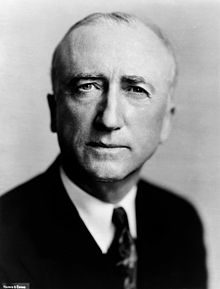
Back James F. Byrnes Afrikaans جيمس بيرنز Arabic جيمس بيرنز ARZ James F. Byrnes AST جیمز اف. بیرنز AZB Джэймс Фрэнсіс Бірнс Byelorussian James F. Byrnes Czech James F. Byrnes Danish James F. Byrnes German James F. Byrnes Spanish
James F. Byrnes | |
|---|---|
 Byrnes in 1941 | |
| 104th Governor of South Carolina | |
| In office January 16, 1951 – January 18, 1955 | |
| Lieutenant | George Bell Timmerman Jr. |
| Preceded by | Strom Thurmond |
| Succeeded by | George Bell Timmerman Jr. |
| 49th United States Secretary of State | |
| In office July 3, 1945 – January 21, 1947 | |
| President | Harry S. Truman |
| Preceded by | Edward Stettinius Jr. |
| Succeeded by | George Marshall |
| Director of the Office of War Mobilization | |
| In office May 27, 1943 – July 3, 1945 | |
| President | Franklin D. Roosevelt (1943–1945) Harry S. Truman (1945) |
| Preceded by | Position established |
| Succeeded by | John Wesley Snyder |
| Director of the Office of Economic Stabilization | |
| In office October 3, 1942 – May 27, 1943 | |
| President | Franklin D. Roosevelt |
| Preceded by | Position established |
| Succeeded by | Fred M. Vinson |
| Associate Justice of the Supreme Court of the United States | |
| In office July 8, 1941 – October 3, 1942[1] | |
| Nominated by | Franklin D. Roosevelt |
| Preceded by | James Clark McReynolds |
| Succeeded by | Wiley Rutledge |
| United States Senator from South Carolina | |
| In office March 4, 1931 – July 8, 1941 | |
| Preceded by | Coleman Livingston Blease |
| Succeeded by | Alva M. Lumpkin |
| Member of the U.S. House of Representatives from South Carolina's 2nd district | |
| In office March 4, 1911 – March 3, 1925 | |
| Preceded by | James Patterson |
| Succeeded by | Butler Hare |
| Personal details | |
| Born | James Francis Byrnes May 2, 1882 Charleston, South Carolina, U.S. |
| Died | April 9, 1972 (aged 89) Columbia, South Carolina, U.S. |
| Political party | Democratic |
| Spouse |
Maude Busch (m. 1906) |
| Signature | |
James Francis Byrnes (US: /ˈbɜːrnz/ BURNZ; May 2, 1882 – April 9, 1972) was an American judge and politician from South Carolina. A member of the Democratic Party, he served in the U.S. Congress and on the U.S. Supreme Court, as well as in the executive branch, most prominently as the 49th U.S. Secretary of State under President Harry S. Truman. Byrnes was also the 104th governor of South Carolina, making him one of the very few politicians to have served in the highest levels of all three branches of the American federal government while also being active in state government.
Born and raised in Charleston, South Carolina, Byrnes pursued a legal career with the help of his cousin, Governor Miles Benjamin McSweeney. Byrnes won election to the U.S. House of Representatives and served from 1911 to 1925. He became a close ally of President Woodrow Wilson and a protégé of Senator Benjamin Tillman. He sought election to the U.S. Senate in 1924 but narrowly lost a runoff election to Coleman Livingston Blease, who had the backing of the Ku Klux Klan, a white-supremacist domestic-terrorist organization.[2] Byrnes then moved his law practice to Spartanburg, South Carolina and prepared for a political comeback. He narrowly defeated Blease in the 1930 Democratic primary and joined the Senate in 1931.
Historian George E. Mowry called Byrnes "the most influential Southern member of Congress between John Calhoun and Lyndon Johnson".[3] In the Senate, Byrnes supported the policies of his longtime friend, President Franklin D. Roosevelt. Byrnes championed the New Deal and sought federal investment in South Carolina water projects. He also supported Roosevelt's foreign policy, calling for a hard line against the Axis powers. He also opposed some of the labor laws proposed by Roosevelt, such as the Fair Labor Standards Act, which established a minimum wage that hurt his state's competitive advantage of very low factory wages. Roosevelt appointed Byrnes to the Supreme Court in 1941 but asked him to join the executive branch after America's entry into World War II. During the war, Byrnes led the Office of Economic Stabilization and the Office of War Mobilization. He was a candidate to replace Henry A. Wallace as Roosevelt's running mate in the 1944 election, but instead Harry S. Truman was nominated by the 1944 Democratic National Convention.
After Roosevelt's death, Byrnes served as a close adviser to Truman and became U.S. Secretary of State in July 1945. In that capacity, Byrnes attended the Potsdam Conference and the Paris Peace Treaties, 1947; however, relations between Byrnes and Truman soured, and Byrnes resigned from the Cabinet in January 1947. He returned to elective politics in 1950 by winning election as the governor of South Carolina. As governor, he opposed the Supreme Court decision in Brown v. Board of Education and sought to establish "separate but equal" as a realistic alternative to the desegregation of schools. Though he remained a Democrat himself, he endorsed most Republican presidential nominees after 1948 and supported Strom Thurmond's switch to the Republican Party in 1964.
- ^ "Justices 1789 to Present". Washington, D.C.: Supreme Court of the United States. Retrieved February 15, 2022.
- ^ "The Ku Klux Klan | National Geographic Society". education.nationalgeographic.org. Retrieved October 14, 2022.
- ^ David Robertson, Sly and Able: A Political Biography of James F. Byrnes (1994), p. 126
© MMXXIII Rich X Search. We shall prevail. All rights reserved. Rich X Search